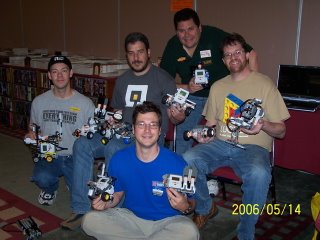
Have a very good time, of course! This weekend (Friday 12 May - Sunday 14 May) several of us got together near Chicago, IL, for the House of Bricks event (this is a small LEGO show within a SciFi/Fantasy convention - a very interesting combination, to be sure). There were several members of the MDP there, including (from left to right) John Brost, Steve Hassenplug, Bryan Bonahoom, Kevin Clague, and myself (seated in front). Between the five of us, there were 10 NXTs present. Yep, 10 of 'em.
So what do you do with this much technology? Play, of course! Both Steve and I have used two NXT kits to make remote-controled vehicles, with one NXT (the remote) sending commands to the NXT vehicle. With two of them (by the end of the weekend we had three), battlebots ensued, as well as other forms of destruction. We mounted a camera on mine so we could video a robots-eye view (video coming when I can edit it - I have something like 3 Gb to sift through). We also used other LEGO sets to make "sphere throwers" that could spit out a series of balls, either under manual control or by looking for the nearest target autonomously and firing a single shot. Some of the other LEGO folks with very nice dioramas even let us drive through them, uprooting trees, running down minifigs, and crashing through the gates of Jurassic Park!
I've posted my NXT-specific pictures in a folder of my Brickshelf account here but the more general pictures of the LEGO portions of the event are in a seperate folder here (these include the robots over-running Jurassic Park, for instance; you'll have to filter through some general LEGO pictures in there).
So why am I telling you this? To let you know about another form of collaboration going on within the MDP and larger LEGO community. We were up every night until about 1-2 AM just talking and building robots, and it's amazing how fast things move when you get that many talented folks in one place. For instance, one night John Brost built a "sphere artillery" that could angle up or down, and fire a sphere. I was watching him build it, and thought I'd give a crack at the programming, so by the time he had completed the build, I already had the program ready to go. Another (non-MDP member) was giving him some ideas on how to make the control mechanism. All of us learned a lot more about the programming language, as well as the curiosities that each of us have learned along the way, from coding tidbits (like how wires feed into and out of Switch structures) to novel uses for pieces (there are small 2L rubber beams in the NXT kits - great for securing odd-shaped non-LEGO devices like cameras), to starting to define standards (Steve and I had similar control models for our remotes - but now they are almost interchangable, which is how we got a third one up and running so fast). Most of the MDP stuff is taking place on-line: after all, we are scattered across at least five continents. But on occassion, when we can get together in person, things tend to rocket forward.
Just think what's going to happen when the rest of the world starts getting NXT set... :-)
Other things we have learned:
- How to make a robot fire a stream of Zamor spheres at roughly 4 spheres per second.
- A NXT robot driven off a table does not bounce (but does contine working. The cameras was taking video from on the robot at the time).
- A LEGO raptor is no match for a NXT with a differential drive (a raptor actually became stuck in the gearing of one robot).
- Remote controls are wonderful, especially when you can drive up behind someone and make the robot suddenly make a series of R2D2 beeps (not just sounding like them, but an actual recording of R2D2).
- The a robot that can roll out of a lair, pan to select the closest object, and tag it with a sphere is endless fun.
- A NXT-based GBC (sort of a Rube Goldberg device for moving LEGO soccer balls) has a lot of potential.
- There is an amazing amount of variety in NXT vehicles. Studless design may be new to some, but it is just as limitless as the old studded constructions. And a lot less likely to come apart when you dump it off a table.
- LEGO folks are a heck of a lot of fun (OK, we knew that before).
- How to make a weight-shifting NXT biped walking robot (it looked very much like the two legged walkers in Star Wars, but somewhat more wobbly).
- Programming at 2 AM in a language you don't fully understand leads to some interesting results.
Brian Davis